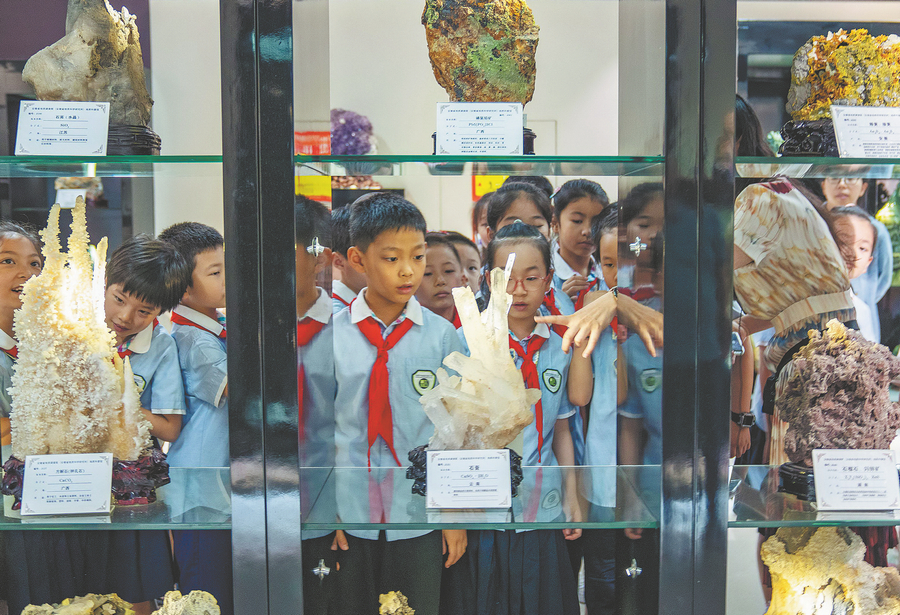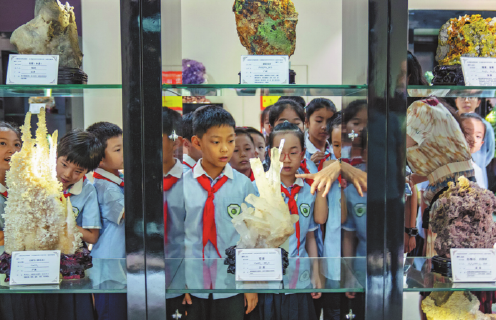

From historic sites to picturesque natural landscapes, from cutting-edge technology innovation hubs to traditional craft workshops, study tours and entertaining journeys are surging in various regions across China this summer, offering grownups and children unique experiences that integrate knowledge, techniques, culture and entertainment.
As a province rich in intangible cultural heritage, Fujian has introduced 275 activities to boost the high-quality development of the local economy and launched a variety of engaging Intangible Cultural Heritage study tours, including hands-on classes on Shoushan stone carving, tea culture training courses, herbal study camps, and bamboo weaving.
On the other hand, at the Yunnan Provincial Museum in Kunming, Southwest China's Yunnan province, students can appreciate the biodiversity and charm of the ancient Dian kingdom (between 278-109 BC). Its bronze artifacts cover a wide range of themes, particularly those related to animals, such as hunting and animal combat scenes, along with unique weapons and ceremonial items from the Dian kingdom. The abundant animal imagery in these bronze pieces reflects the people's observation and reverence for nature at that time.
Wei Jian, deputy director of the museum, said that through the study tour, young people can understand the stories behind the artifacts, allowing them to express themselves while inheriting the essence of Chinese culture.
At Xinjiang Academy in Xinzhou district of Shangrao, Jiangxi province, children participate in activities highlighting ICH performances, rubbings and calligraphy.
A Xinzhou Daoqing performance titled Beloved China was staged at the academy, with performers dressed in traditional costumes, holding folk instruments, and using expressive poses to showcase the charm of traditional cultures. Xinzhou Daoqing is a local form of traditional Chinese performing arts that is presented through storytelling, singing and acting.
The Xinjiang Academy also collaborates with educational departments to organize arts activities, including rubbings. To complete a rubbing artwork, children paste rice paper on engraved tablets, moisten it with water, cover it with a towel, gently tap it with a small hammer, and then color the embossed characters and patterns with a small brush dipped in red ink.
The academy received nearly 5,000 students for study tour activities during the summer vacation, according to Chen Zhiyao, director of the Xinjiang Academy. "In the new era, we are taking on the role of extracurricular social education, ensuring the transmission of cultural heritage," Chen said.
Nowadays, study tours extend to Hong Kong, Macao, Taiwan and Chinese communities overseas, becoming an important bridge connecting the shared emotions and cultural identity of the Chinese nation.
Recently, the launch ceremony for the 2024 Hong Kong and Macao Youths Study Tour was held in Wuhan, Hubei province. Nearly 400 young people from Hong Kong, Macao and Shenzhen embarked on a 12-day study tour of the Chinese mainland.
This event offered several study tour routes, including Chu culture, Three Kingdoms (220-280) culture, the ancient Tea Horse Road, traditional Chinese medicine, science and technology, and revolutionary culture. Through these tours, students can savor the beauty of the local landscape, the richness of culture and developmental achievements, all while experiencing the grandeur of the motherland.
wangjinhui@chinadaily.com.cn
